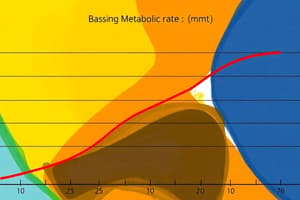Podcast
Questions and Answers
What is the Basal Metabolic Rate?
What is the Basal Metabolic Rate?
- Energy consumed in physical activities
- Energy to maintain life-sustaining activities at rest (correct)
- Calories consumed from food
- Total energy expenditure during the day
What is Resting Energy Expenditure?
What is Resting Energy Expenditure?
Amount of energy needed over 24 hours to maintain internal activities at rest.
What unit measures energy?
What unit measures energy?
Kilocalories
Nutrients are elements necessary for normal body functions.
Nutrients are elements necessary for normal body functions.
What does nutrient density refer to?
What does nutrient density refer to?
Essential Nutrients must be obtained from _______
Essential Nutrients must be obtained from _______
What are the six essential nutrients?
What are the six essential nutrients?
How many kcal/g do carbohydrates and proteins provide?
How many kcal/g do carbohydrates and proteins provide?
How many kcal/g do fats provide?
How many kcal/g do fats provide?
What are simple carbohydrates comprised of?
What are simple carbohydrates comprised of?
What are polysaccharides?
What are polysaccharides?
What forms the simplest unit of protein?
What forms the simplest unit of protein?
What are the nine essential amino acids?
What are the nine essential amino acids?
Saturated fatty acids have two attached hydrogen atoms to each carbon atom.
Saturated fatty acids have two attached hydrogen atoms to each carbon atom.
What is considered a healthy body mass index?
What is considered a healthy body mass index?
What factors contribute to obesity?
What factors contribute to obesity?
What is the primary function of water in the body?
What is the primary function of water in the body?
What are the major minerals?
What are the major minerals?
Vitamin A is known as the ______ vitamin.
Vitamin A is known as the ______ vitamin.
Vitamin D is important for the absorption of ______.
Vitamin D is important for the absorption of ______.
What are the food groups?
What are the food groups?
What color represents fruits?
What color represents fruits?
What are the ten tips for a great plate?
What are the ten tips for a great plate?
What influences food choices?
What influences food choices?
What does diet therapy consist of?
What does diet therapy consist of?
What is TPN?
What is TPN?
Diverticulosis refers to __________.
Diverticulosis refers to __________.
What is dumping syndrome?
What is dumping syndrome?
Flashcards are hidden until you start studying
Study Notes
Metabolic Rates and Energy
- Basal Metabolic Rate (BMR): Energy required to maintain vital functions at rest, including heart rate and body temperature.
- Resting Energy Expenditure (REE): Total energy needed by an individual at rest over a 24-hour period to sustain bodily functions.
- Kilocalories (kcal): The standard unit for measuring energy in food.
Nutrients and Their Characteristics
- Nutrients: Essential elements for normal body functions.
- Nutrient Density: Measure of nutrients in relation to calories provided.
- Essential Nutrients: Nutrients that must be consumed as the body cannot produce enough on its own.
- Six Essential Nutrients: Water, Carbohydrates, Fats, Proteins, Vitamins, Minerals.
Carbohydrates
- Preferred energy source for the body.
- Simple Carbohydrates: Include monosaccharides (e.g., glucose) and disaccharides (e.g., sucrose).
- Complex Carbohydrates: Composed of polysaccharides (e.g., starch, glycogen).
- Nutritional Content: Carbohydrates and proteins provide 4 kcal/g, while fats provide 9 kcal/g.
Proteins
- Composed mainly of hydrogen, oxygen, and nitrogen.
- Amino Acids: The simplest building blocks of proteins; essential amino acids must be obtained through diet.
- Types of Proteins:
- Complete Proteins: Contain all essential amino acids (typically animal sources).
- Simple Proteins: Consist of one amino acid type.
Fats and Lipids
- Types of Fatty Acids:
- Saturated: Found in animal products; each carbon atom is bonded to two hydrogen atoms.
- Unsaturated: Found in plant sources; equal number of hydrogen to carbon atoms.
- HDL (High-Density Lipoprotein): Known as 'good' cholesterol.
- LDL (Low-Density Lipoprotein): Considered 'bad' cholesterol.
Water and Its Importance
- Water constitutes 60-70% of body weight; higher percentage in lean individuals, lower in older adults.
- Functions: Transports nutrients, assists metabolic reactions, regulates temperature, lubricates joints.
Vitamins and Minerals
- Vitamins are categorized into fat-soluble (A, D, E, K) and water-soluble (B, C).
- Major Minerals: Include sodium, chloride, potassium, and calcium.
- Calcium plays a vital role in bone health and is regulated by sodium.
Body Mass Index (BMI)
- Healthy BMI Range: 18.5 - 25.
- Overweight: BMI of 25 - 30.
- Obesity: BMI of 30 or higher; influenced by sedentary lifestyles, unhealthy eating habits, and economic factors.
Dietary Guidelines
- “10 Tips to a Great Plate” promote balanced calorie intake and encourage consumption of whole grains, fruits, vegetables, and low-fat dairy while limiting high-calorie and high-sugar foods.
Diet Therapy and Nutrition Support
- Types of Diet Therapies: Clear liquids, full liquids, pureed, mechanical soft, soft/low residue, high fiber, low sodium, low cholesterol, diabetic, regular diets.
- Parenteral Nutrition:
- PPN (Peripheral Parenteral Nutrition): Short-term feeding with lower risk and cost.
- TPN (Total Parenteral Nutrition): Longer-term, central vein feeding requiring monitoring.
Digestive Health Concerns
- Diverticulosis: Condition characterized by abnormal pouches in the intestinal wall.
- Dumping Syndrome: Rapid gastric emptying leading to symptoms like abdominal pain, nausea, and diarrhea.
Studying That Suits You
Use AI to generate personalized quizzes and flashcards to suit your learning preferences.




